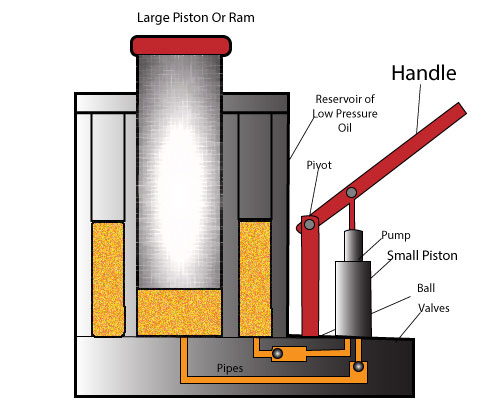In this article, we discussed briefly how jack works? Also, we tried to explain different types of jack mechanisms such as how the hydraulic, bottle, and scissor jack works? The answer of how does a car jack works also applicable for how does a truck jack works. So without further ado lets dive into the article.
How Does A Car Jack Work?
A car jack uses mechanically operated arrangements to lift up and lower. The ratcheting system boosts its versatility. You need to know how each type of car jack works. Most popular car jacks include:
- Hydraulic Floor Jacks
- Bottle jacks
- Scissor jacks
If you want to know the which are the best jack for lifted car then check the link. Now, Let’s discuss how each jack works.
How Does a Hydraulic Floor Jack Work?
A Hydraulic jack uses physical energy to lift and lower heavy load. In order to generate power, the compression of fluids must apply. One of the common fluids used in this process is oil. But how does it work?

Anyone who has used this kind of jack knows that it uses an incompressible liquid. To help you understand how a hydraulic jack operates, it’s good to be aware of its primary components such as:
- Check valve
- Buffer tank or reservoir
- Release valve
- 2 Pump cylinders
- Pump with plunger or piston
- Handle or pump level
First, the jack has a buffer tank/reservoir that holds the fluid (oil). Through the mechanism known as Pascal’s Principle, the jack exerts pressure by moving the oil through two cylinders via the pump plunger.
Remember that the amount of pressure applied to one cylinder is the same pressure imparted to the second cylinder. At this point, the main cylinder is full of liquid pressure.
Once the plunger is pushed downwards, the fluid (oil) is slowly transported through the discharge check valve and direct into the cylinder chamber. This makes the suction valve to close. At the same time, there’s pressure built up in the chamber.
As a result, the piston in the chamber rises and lifts up any heavy object. You can repeat the process many times if you want to lift your load higher as desired.
If you’re done with lifting and you want to your car or truck, just turn the release valves slowly. The release valves usually drain the fluid force from the cylinder then to the reservoir. Within no time, the jack slowly returns to its normal or original position.
How Does a Bottle Jack Work?
Also referred to as hand jacks, bottle jacks can allow you to lift your vehicle for an inspection or roadside service. A bottle jack features a vertical shaft that aids in holding the weight.
Bottle jacks are generally built with a cylinder and a piston. Just like a floor jack, this tool makes use of fluid power to exert force.
When the user pulls up the lever, oil is drawn up into the cylinder. When pushed down, more pressure is exerted. The movements and exerted pressure cause the piston to rise. As you carry on with, the piston slowly rises, hence lifting up the car.
How Does a Scissor Jack Work?
While a hydraulic jack is operated by fluid, a scissor jack is screw-operated. For standard road cars, screw jacks are most common. Their ability to deliver an ultimate mechanical advantage is the reason for their popularity.
Through the locking central screw, the jack operates superbly. This comes along with the help of a key-shaped metal arm. Practically, when turned clockwise, the arm drives this screw through a central scissor mechanism pivot point.
Then, the jack elongates and raises the vehicle. To lower your car, just rotate your screw counter-clockwise. This unthreads the jacks making it shorten and lower the load to the ground.
Last Updated on February 25, 2025 by Rifen
